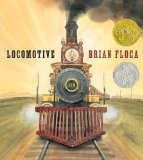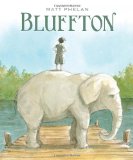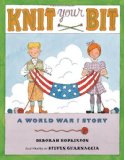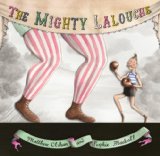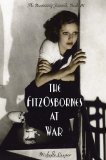Review of Locomotive, by Brian Floca
by Brian Floca
Atheneum Books for Young Readers, 2013. 64 pages.
Starred Review
2014 Caldecott Medal
2014 Sibert Honor Book
Our library is shelving this with nonfiction, and I think I’m going to list it there. Technically, this is a fictional story, but the book is more about facts than the story of the travelers featured. The story merely provides a frame for telling about steam travel across the country as it would have been in 1869, when the transcontinental railroad went all the way through.
The charm of this book lies in the magnificent artwork. The book is a large square shape, with lots of room for details. Small train lovers as well as big train lovers will be delighted to pore over each page.
The basic text tells a fairly simple story of a family traveling to meet their father and husband in California, addressing the reader, telling you what it would have been like.
Now comes the locomotive!
The iron horse, the great machine!
Fifty feet and forty tons,
wheels spinning, rods swinging,
motion within motion, running down the track!
She’s bright in her paint and her polish —
the pride of her company and crew.
She pulls her tender and train behind her,
she rolls up close to where you wait,
all heat and smoke and noise:Hear the clear, hard call of her bell:
Clang-clang! Clang-clang! Clang-clang!Hear the Hisssssssss and the Spit of the steam!
Hear the engine breathe like a beast:
Huff Huff Huff!
Brian Floca uses font, size, and position on the page to make the words themselves part of the story, especially the sound effects. On this page, the words come closer and push the family back, as they gaze at the giant locomotive.
The journey goes all the way across the country, and so many details are given. Pictures of landmarks decorate the pages, and we see the different kinds of terrain, what the passengers are doing, and what the train workers are doing, from the boy who sells newspapers to the engineer.
The extra large pages give the reader both panoramic vistas and extreme close-ups to things like the engine and the mighty wheels. The inside front cover tells about building the Transcontinental Railroad and the inside back cover tells about how steam power works in the locomotive. No space is wasted.
This book is a train-loving kid’s dream come true. And it may create some train lovers as well.
brianfloca.com
KIDS.SimonandSchuster.com
Find this review on Sonderbooks at: www.sonderbooks.com/Childrens_Nonfiction/locomotive.html
Disclosure: I am an Amazon Affiliate, and will earn a small percentage if you order a book on Amazon after clicking through from my site.
Source: This review is based on a library book from Fairfax County Public Library.
Disclaimer: I am a professional librarian, but I maintain my website and blogs on my own time. The views expressed are solely my own, and in no way represent the official views of my employer or of any committee or group of which I am part.
